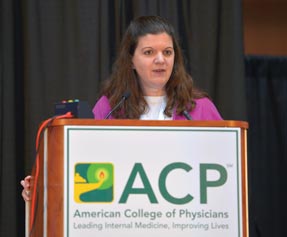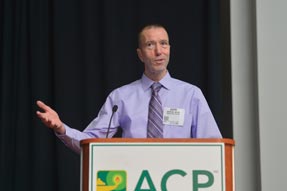NAFLD treatment starts with weight loss, then other modes
Nonalcoholic fatty liver disease (NAFLD), which accounts for 30% to 40% of chronic liver disease in the U.S. today, is the hepatic manifestation of the metabolic syndrome and is associated with sleep apnea, cardiovascular disease, and diabetes.
Chronic hepatitis C may get a lot of press, but it isn't the most common chronic liver disease in the U.S. today. That would be nonalcoholic fatty liver disease (NAFLD), which accounts for 30% to 40% of cases, Lieutenant Colonel Dawn M. Torres, MD, told an audience of Internal Medicine Meeting 2016 attendees at her session, “Evolving Paradigms in Chronic Hepatitis.”
All patients who have fatty liver disease that is not a result of drinking alcohol fall under the umbrella of NAFLD, said Dr. Torres, who is chief of the gastroenterology service in the department of medicine at Walter Reed National Military Medical Center in Bethesda, Md. Nonalcoholic fatty liver disease can't be distinguished from alcoholic fatty liver disease on biopsy, so it's important to get a history of alcohol use to differentiate between them, Dr. Torres said.

Nonalcoholic steatohepatitis (NASH) is a subset of NAFLD that involves necroinflammation in addition to fat, as well as fibrosis. “It's those patients with NASH that are at the greatest risk for progression to cirrhosis or liver cancer, and so those are the ones we want to identify and develop treatments for,” she said.
Risk factors, diagnosis
NAFLD is the hepatic manifestation of the metabolic syndrome and is associated with several conditions, Dr. Torres said, with the “big 3” being sleep apnea, cardiovascular disease, and diabetes. Visceral adiposity, ethnicity, and insulin resistance are all important factors in the development of NAFLD, she reported. Patients at high risk include those who are diabetic, those who are Hispanic, those who have a body mass index above 28 kg/m2, those with an aspartate aminotransferase/alanine aminotransferase ratio of 0.8 or higher, and those with coexisting liver disease such as hepatitis C.
Dr. Torres called the decision of which patients to biopsy “a real diagnostic dilemma” and encouraged attendees to develop a method of risk stratification in their clinical practices, such as noninvasive scoring systems. “You can take your pick of one. I like the NAFLD fibrosis score; there's a nice online calculator for it. It uses parameters that you'll have available in your clinical practice to calculate their risk of having fibrosis,” Dr. Torres said. (The score is available online )
She also noted that noninvasive radiographic techniques to detect and measure fibrosis, such as transient elastography (FibroScan) and magnetic resonance elastography, are becoming available. “I think this is really an area of growth and you'll see it more and more in clinical practice,” she said. She recommended biopsying patients whose NAFLD fibrosis score suggests fibrosis, those who have an elevated transient elastography or elastography score, and those in whom a 6- to 12-month trial of lifestyle modification has failed to yield improvement. In the last group, Dr. Torres considers biopsy a potential motivating tool.
“What's tragic is when you see somebody 5 years down the road after having elevated liver enzymes, and they've been told ‘It's OK, it's OK,’ when maybe if you did that biopsy up front to look for steatohepatitis, that would have triggered a significant lifestyle modification,” she said.
Diet and exercise
Patients with NAFLD often have diets high in saturated fat and cholesterol and low in polyunsaturated fat, fiber, and antioxidant vitamins C and E. They also often have a high intake of soft drinks and meat, low intake of omega-3 fatty acids, and an overall energy intake higher than their energy expenditure. High-fructose diets may also contribute to NAFLD, Dr. Torres noted.
“One thing I tell my patients in clinical practice is ‘Sugar sodas have to go immediately.’ And you'd be surprised how many people are drinking half a container of orange juice a day, thinking that's a healthy thing, and really that's just a tremendous sugar load. So that's something that you can emphasize with your patients,” she said.
Regarding treatment, “Weight loss works,” said Dr. Torres. “It's the best treatment that there is for NASH.” Losing 9% to 10% of body weight can improve both metabolic and histologic parameters, including insulin sensitivity, liver enzymes, visceral adiposity, hepatic steatosis, ballooning degeneration, and lobular inflammation, she noted. However, sustaining weight loss is tough, Dr. Torres said, and support from a nutritionist can be necessary, especially for those with a sedentary lifestyle. “It's not just the food; it's also the activity level that they incorporate into their day-to-day life,” she said.
Research has shown that patients need to expend the equivalent of 400 kcal per session 3 times per week to improve insulin sensitivity, Dr. Torres noted. “That's kind of a lot, if you think of what your patients may consider as exercise,” she said. The overall energy expenditure achieved per workout is more important than workout intensity, said Dr. Torres, “so patients may have to build up to that. It may take them an hour of walking to get up to 400 kilocalories.” Resistance training is also helpful, so a combination is recommended, she said.
Other treatments
Dr. Torres stressed that lifestyle modifications remain the cornerstone of therapy but also discussed other treatments. Bariatric surgery, for example, has been looked at extensively in patients with NASH, and newer procedures, such as Roux-en-Y gastric bypass, have been found to improve NASH histology, she noted. However, because bariatric surgery is an invasive procedure and carries risk of complications, “I wouldn't refer patients to bariatric surgery just for NASH,” Dr. Torres said. She recommended that it be considered in NASH patients who have other comorbid conditions that might benefit and who haven't had success with lifestyle changes.
Among weight loss drugs, orlistat has been found to provide benefit in NASH, but only if patients lose weight. “It's not independently of benefit; it's only as an adjunct if they're able to lose weight,” Dr. Torres said. Among incretin mimetics and enhancers, a small pilot trial, in which Dr. Torres was involved, found daily exenatide to provide modest weight loss and improvement in hepatic steatosis, with its major side effect being nausea. Larger randomized controlled trials are in progress testing a weekly extended-release formulation, Dr. Torres said.
Sitagliptin and vildagliptin, meanwhile, have been found to have a more neutral effect on weight loss and have not been studied in NAFLD. “Potentially they may not work as well, but it's really [that] they haven't been studied, so it's hard to say,” Dr. Torres noted.
Of diabetic medications, metformin has had mixed results in adult NAFLD, improving hepatic steatosis but yielding no significant improvement in fibrosis and necroinflammation, Dr. Torres said. “It's a great medicine for diabetes, but it's not our medicine for NASH in adults or children,” she said.
In contrast, pioglitazone has been well studied in NASH and has been found to decrease insulin resistance and improve hepatic histology, although with modest fibrosis benefit, Dr. Torres said. However, it can also cause weight gain of 5 to 10 pounds over a year of therapy. “That's really a bitter pill to swallow for a patient who you're telling to diet and exercise and lose weight,” she said.
Pioglitazone also carries a black-box warning for congestive heart failure and is linked to bone fracture risk in diabetes, and the benefits of the drug are short-lived after therapy is discontinued. Guidelines from the American Association for the Study of Liver Diseases (AASLD), the American College of Gastroenterology (ACG), and the American Gastroenterological Association (AGA) include pioglitazone as a treatment for biopsy-proven NASH but caution that physicians should understand the drug's side effects, that most patients in clinical trials were nondiabetic, and that the long-term efficacy and safety of the therapy have not been proven for NASH, Dr. Torres noted.
“I think it's reasonable to consider [pioglitazone] if you're struggling [with] what to give a diabetic NASH patient without heart failure who can tolerate modest weight gain, so that's a lot of caveats,” she said.
Vitamin E has been shown to mainly improve ballooning steatosis and lobular inflammation, Dr. Torres said. “The fibrosis benefit is modest, if any,” she noted. Drawbacks include a potential increase in all-cause mortality with vitamin E supplementation and a modest increase in prostate cancer with a dose of 400 IU a day, although the absolute increase of the latter is fairly low, Dr. Torres said. It is guideline-recommended for nondiabetic NASH patients, and Dr. Torres said that it is reasonable to consider in this group. “I will use this once in a while in my clinical practice. I tend to use the lower dose, 400 IU once a day,” she said.
Regarding pentoxifylline, “There's some evidence to indicate that maybe this will be a therapy for NASH. It's being studied further,” Dr. Torres said. It's not mentioned in the AASLD/ACG/AGA guidelines but is safe, with some GI side effects, and has moderate-quality evidence supporting decreased steatosis, fibrosis, and lobular inflammation, she noted. It can be considered in NASH patients who are not eligible for vitamin E or pioglitazone. “If a patient really wanted to be on a medicine, this is probably something safe to prescribe. Just know that it does not have an FDA indication for NASH,” Dr. Torres said.
As for statins, Dr. Torres noted that many patients with NAFLD meet treatment guidelines for statin therapy for cardiovascular benefit. The AALSD/ACG/AGA guidelines recommend statins for hyperlipidemia in NASH patients but not specifically to treat NASH, she said. But, she added, “They're extremely safe. I think the take-home message from this is that if a patient has risk factors for cardiovascular disease and they have NASH, it is OK to put them on a statin, even if their liver enzymes are 2 to 3 times elevated [above normal] at baseline.”
Dr. Torres noted that patients' liver enzymes may increase a bit further during statin therapy but said that this shouldn't be a cause for concern. “I probably would allow 2, maybe even 3 times what the baseline was when you started the statin before I would even consider discontinuing it,” she said. “I see a lot of patients who come to me for their elevated liver enzymes and their statin's been held, and I'll restart it for them.”





